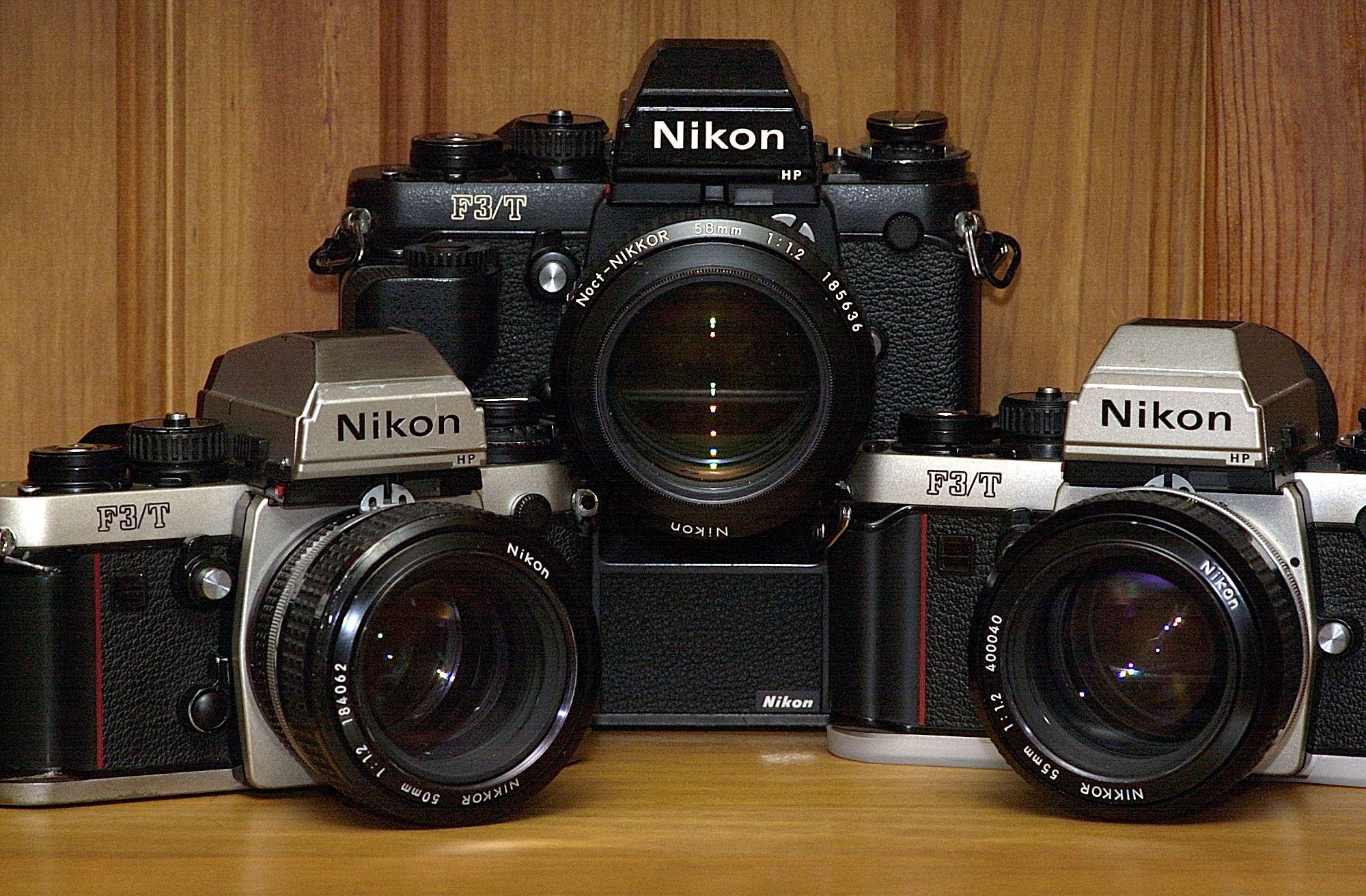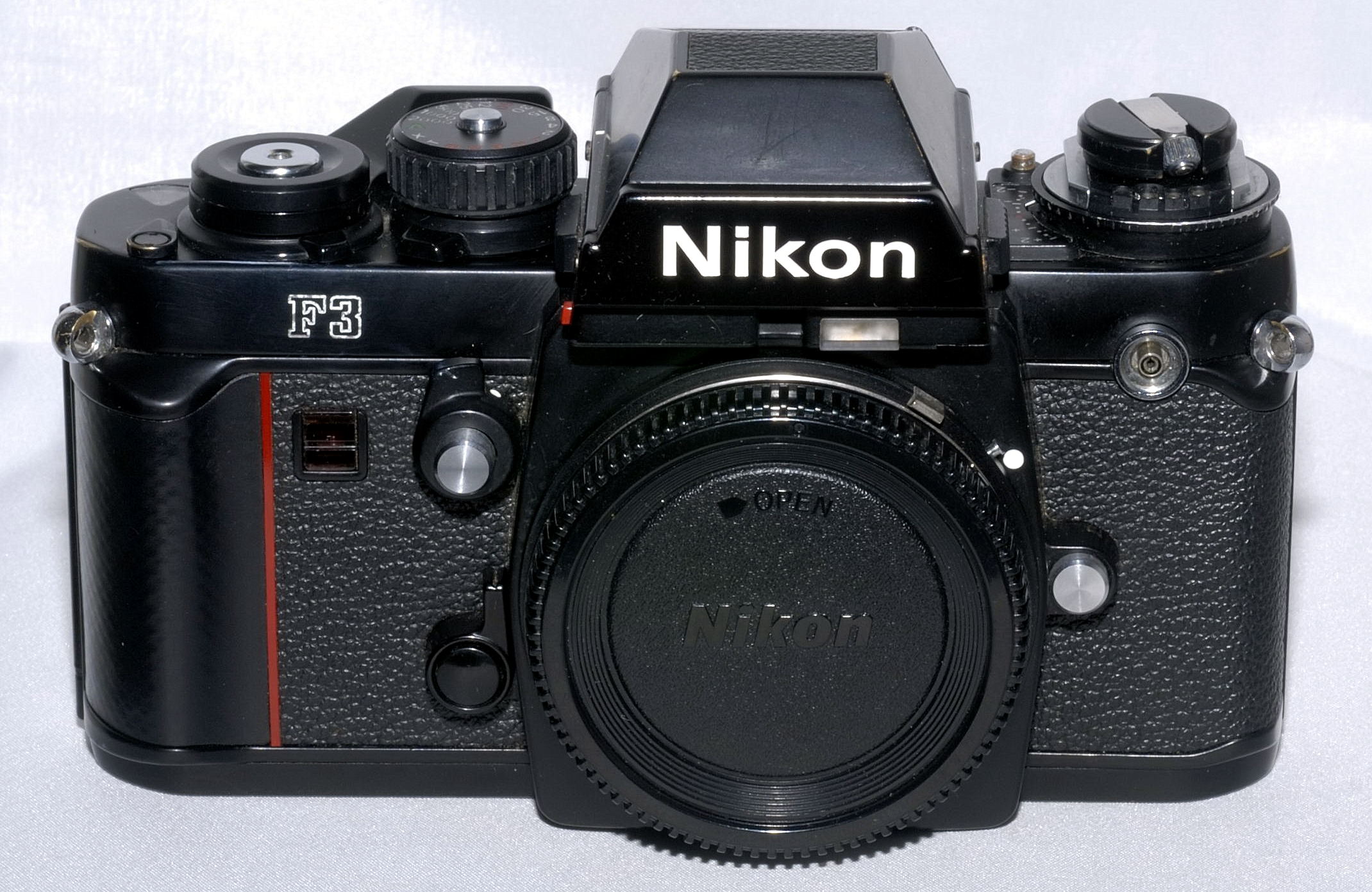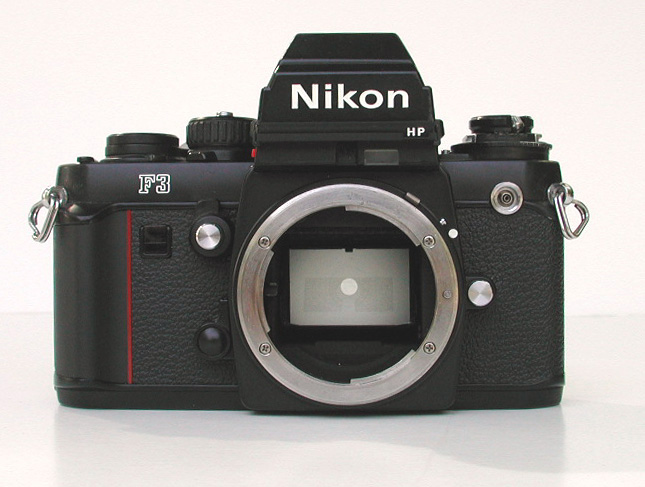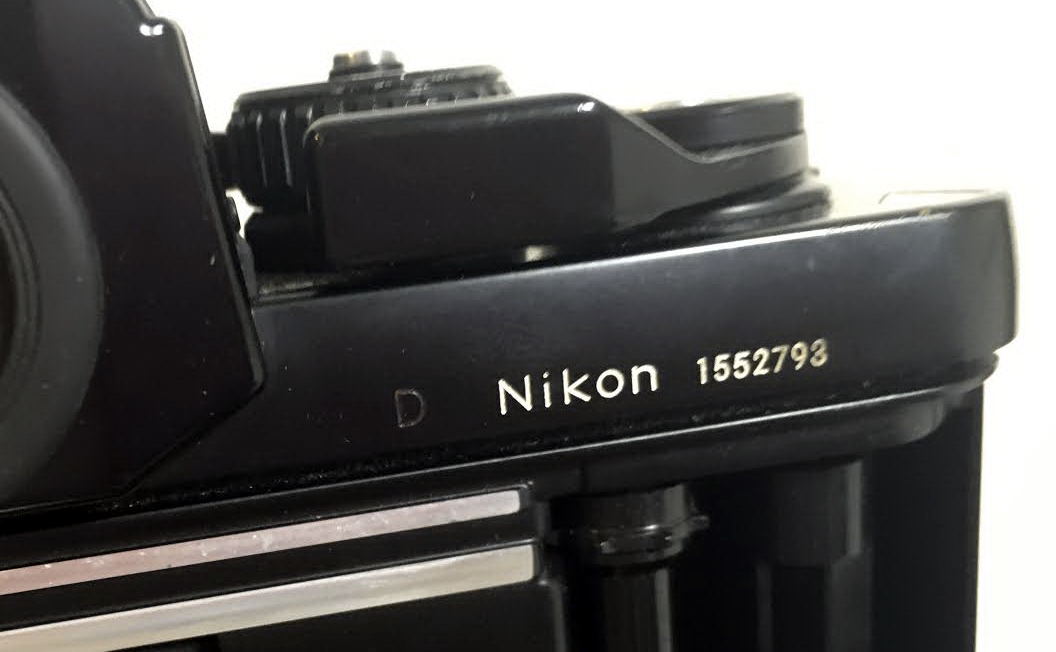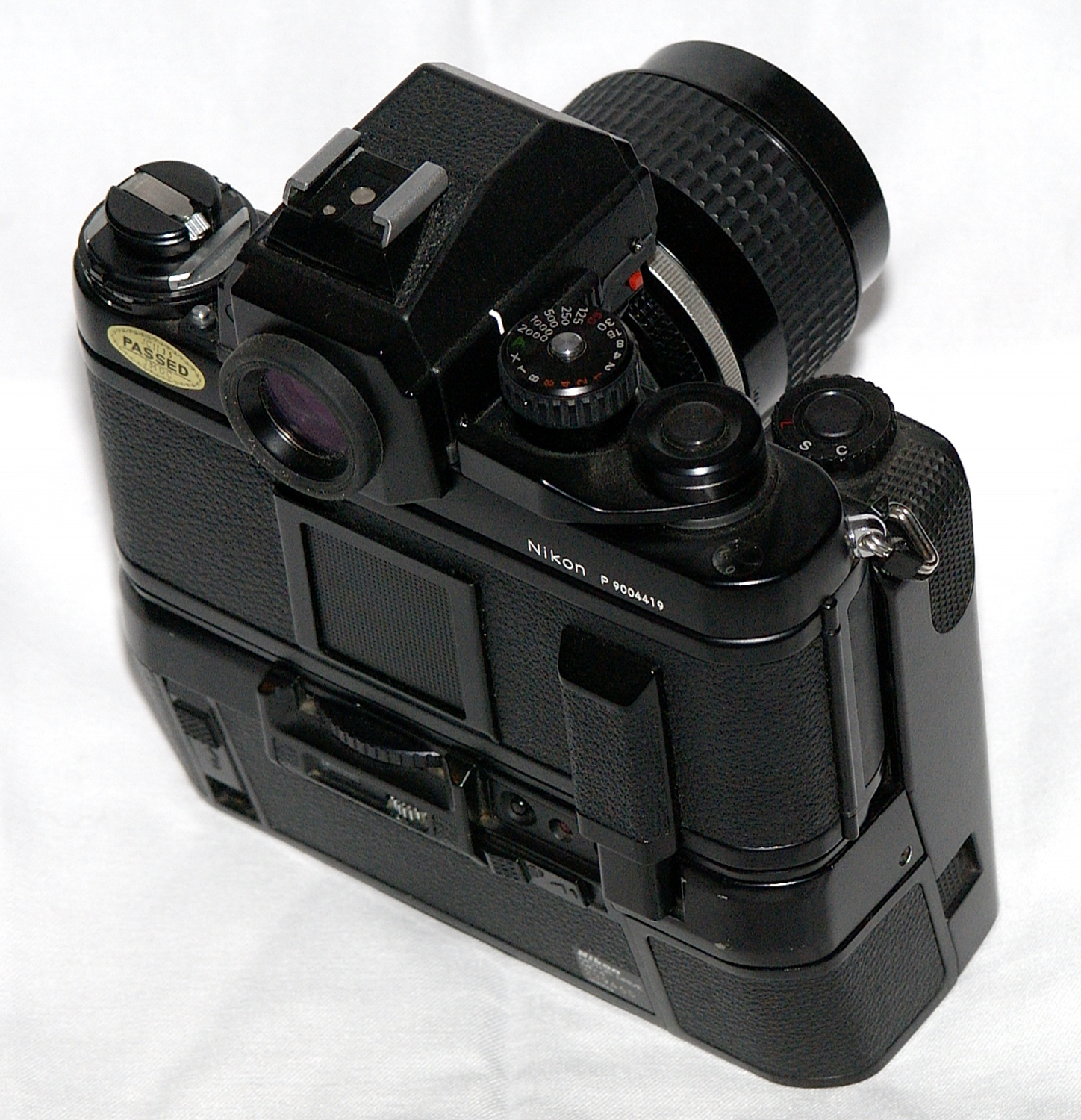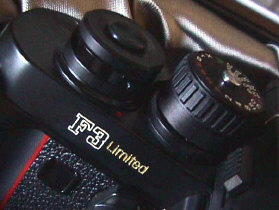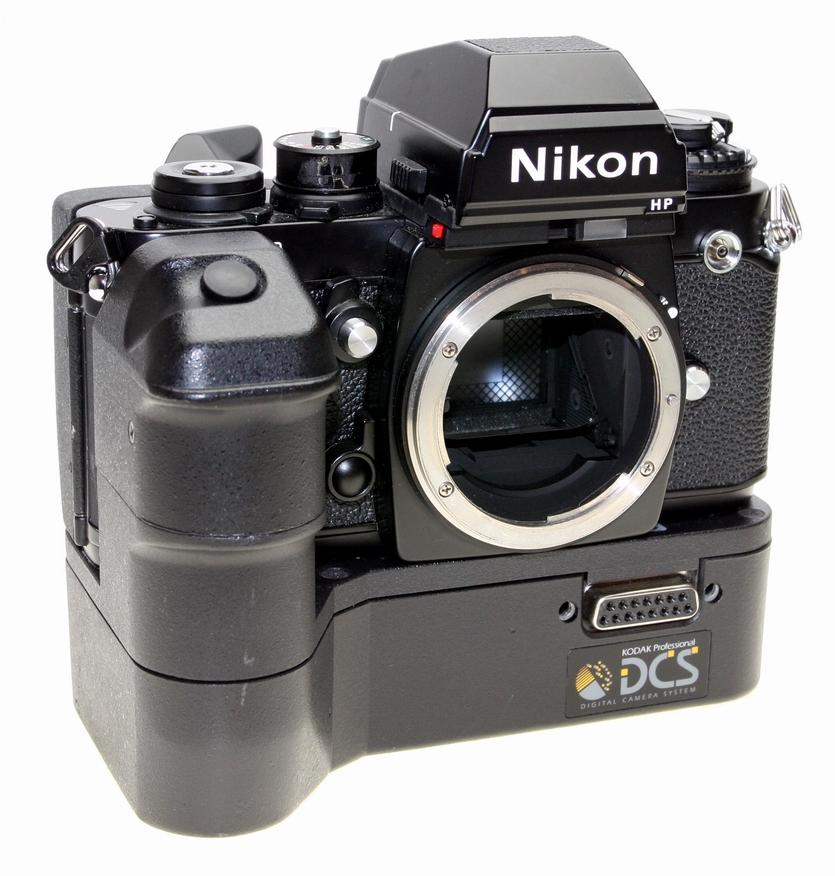Nikon F3First professional SLR with automatic exposure program
A nice collection of rare Nikon F3 versions: Nikon F3/T = black titanium and ´champagne´ versions fitted with the three fastest standard Nikkors.
In the early 1970´s Nikon Corporation was thinking about fitting an electronic shutter in a professional single lens reflex camera (SLR). Nikon already gained some experience with the electronic Copal shutter in several Nikkormat models. The question was, however, how and where to put that shutter in a Nikon F2. In 1973 Nikon started the development of the Nikon F3 as we know it now. Many prototypes - on the basis of the Nikon F2 - were build. The new camera had to be a camera, like its predecessors, which could be ´dressed´ with screens, viewfinders, backs, motor drives, etc. But the electronic shutter should also control an automatic exposure program. There was an insurmountable problem: how to fit this automatic control system into the existing Photomic viewfinder! To fit such a system in all versions of the Photomic viewfinders was too complicated and would make them too big. Nikon´s ´Engineering and Development Group´ had to find another solution. That solution was found in 1976. The exposure meter should not find its place in a viewfinder but inside the camera body. The light beams entering the camera would be partly caught through a pin hole mirror by a sensor under the mirror. At the lower part of the mirror specially grinded glass leads about 8 % of the light to a secondary mirror with special lenses down to a sensor deep in the mirror house. The area of the grinded mirror is in fact non-visible: 50,000 non-reflecting dots of 20x30 micron. This solution coincided with the invention and the application of an electro-magnetic, quartz controlled, shutter management and a little LCD (liquid crystal display) screen. There was something else special to this camera. It was designed by the famous Italian car designer Giorgetto Giugiaro, who was introduced to Nikon´s management by the well-known Japanese automotive journalist, Kazuhiko Mitsumoto. Giugiaro not only designed this camera and its winder MD-4, but many more cameras, like Nikon´s first compact camera, the Nikon 35AF. His most remarkable 'invention' in his designs is the red line on the black bodies of many Nikons. In March 1980 this new ´camera of the 1980´s´ was shown in Japan to the press. That this camera became a success may be confirmed by its production time: 21 years !! As is the case with the Nikon F and Nikon F2 series, this camera system consists of a camera body, that can be expanded with several accessories. 5 different viewfinders could be ordered as well as 22 (!) different viewfinder screens. The motor drive MD-4 has a top speed of 4 to 6 frames per second, but with the MD-4H even 13 fps. are possible. All models were painted in black, except the Nikon F3/T (shown above). To find out when your Nikon F3 was produced see this Nikon F3 serial number matrix. The following Nikon F3 versions exist: Nikon F3
Standard model with the DE-2 standard viewfinder. Serial number start at 1200001. The most interesting technical specifications of the basic camera body are: electro-magnetic, quartz controlled, horizontally traveling titanium foil shutter with a speed range from 8 - 1/2000 sec., B & T and - if batteries are empty - a mechanical shutter speed of 1/60 sec.; flash synch 1/80 sec. Self timer 10 sec. TTL exposure metering by 1 silicon photo diode (SPD) (placed under the mirror) with a sensitivity range of 1 - 18 EV (correction of -2/+2 possible in 1/3 steps); 12 - 6400 ISO. Powered by 2 x 1.55 Volt silver oxide (S-76 or SR-44) batteries, 2 x 1.5 Volt alkaline-manganese batteries or 1 x 3 Volt lithium battery (CR-1 3N). When MD-4 is used motor drive powers the camera. LCD-screen indicating shutter speed and under/over exposure. DOF button. The little aperture coupling lid on top of the F-mount can be lifted by pressing the little button next to it. This makes it possible to use non-AI-lenses. In fact you may use all Nikkor lenses ever produced as long as they have an aperture ring. All camera bodies have the same layout. 1. strap lug (on both sides); 2. external flash connector; 3. lens release button; 4. flash shoe + contact; 5. rewind lever; 6. ISO adjustment release button with scale (lift ring under flash shoe); 7. back door release button (press to the right and pull rewind lever); 8. DOF button and mirror lock-up button; 9. mechanical shutter release button; 10. self timer indicator; 11. self timer lever; 12. shutter speed selector; 13. shutter lock; 14. multiple frame button; 15. frame counter; 16. film advance lever and shutter release button. The little red button next to the DOF button can be pressed for illumination of the aperture readout window. It has a delicate little lamp often being the first part of this strong camera to break down. The viewfinder has on both sides a button which should be shifted backward before lifting the finder. Nikon F3 HP
Standard model but fitted (since March 1982) with a ´high eye point´ viewfinder (DE-3), enabling to look at a distance of 25 mm. At the front of the viewfinder the letters ´HP´ in white are engraved.
For promotional purposes (Demo?) an unknown number of Nikon HP cameras with a red 'D' engraving were produced. All of them in the #155xxxx range. (Courtesy Ron V.) Nikon F3 AF
Nikon F3AF + AF-Nikkor 2.8/80 mm. + AF-Nikkor 3.5/200 mm + TC-16 In April 1983 the first Nikon auto focus camera was offered. The auto focus sensor is built in the special viewfinder DX-1. Two silicon cells focus on a contrast base. A second version has an on/off switch. The finder is powered by two AAA-batteries, which also power the two special lenses Nikon build for this camera (2.8/80mm. + 3.5/200mm.). The viewfinder, with one fixed screen, can be used on other camera versions as well (after removing the viewfinder screen of that camera first!), but only as a focusing assistant. Other viewfinders can be used on the Nikon F3AF. The TC-16 can convert some manual focus Nikkors into an autofocus lens. The two letters ´AF´ are engraved on the camera front, next to F3. Serial numbers of this special camera start at AF 8300001. Nikon F3/TBlack Nikon F3/T with MF-4 250 Back + MD-4 Motor Drive + AH-3 Tripod adapter + Nikkor 1.2/55mm.
On top of this page the special Nikon F3/T (T = titanium) is pictured, introduced in December 1982. The bottom, top covers, viewfinder cover and the back are made of a titanium alloy, which makes this camera body nearly indestructible. Titanium is a very strong but light metal. The titanium color resembles to Champagne wine, so some publicists gave this version this flattering name. A few years later a black painted titanium version was introduced. Both version have the HP viewfinder (DE-4) and inside some IC´s are covered by a synthetic layer, making the camera impervious to moisture. Serial numbers start at T 8200001 for the ´champagne´-model, for the black Nikon F3/T numbering starts at T8500001. Nikon F3P
This heavy duty version was meant for photographers working in harsh situations (bad weather, war time, etc.). It has some better sealing, a titanium HP viewfinder (DE-5) with a flash shoe, higher shutter selector, but no double exposure button, no closeable viewfinder window and a different on/off switch and round frame counter window. It was fitted with a special back (MF-6B), which - in combination with the MD-4 - rewinds the film in a way that a little piece of film remains outside the film cassette. Serial numbers of the Nikon F3P start at P9000001. Nikon F3 Limited
This version was introduced in October 1993 in Japan only. It was based on the Nikon F3P. Serial numbers started at L 9500001. Nikon F3 High SpeedNikon F3 High Speed with MD-4H Motor Drive. In Spring 1996 a special Nikon F3P version was fitted with a special motor drive, as the name indicates: for high speed. This motor drive has a top speed of 13 fps. To obtain that top speed the mirror is a fixed type with a special surface. 70 % of the light goes to the film, only 30 % is visible in the viewfinder. Exposure metering via stop down method; an extra large DOF-button was fitted for this reason. The lay out of the camera body is based on the Nikon F3P. Serial numbers start at H9600001. Serial numbers of the Motor Drive Nikon MD-4H start at H960001. Nikon F3 specialsFor special clients special versions were produced. NASA e.g. was and is still an important client. It ordered several special Nikon F3´s in the 1980´s for its ´Space shuttle´, Challenger´ and ´Columbia´ space programs. These specially made Nikon´s are very rare and thus there are many fake cameras on the market. A special body was constructed with a larger mirror house and prism viewfinder. This ´camera´ was meant to present all viewfinder screens and viewfinder correction lenses. This F3 Screen is a rare collector´s item as well. Many manufacturers, other than Nikon, produced a great variety of accessories, like polaroid backs, digital backs, underwater housings, telescope and periscope tubes, etc. etc. It is impossible to list them here as nobody has a complete overview.
The Nikon F3 was chosen - as the very first Nikon SLR - for one of the first digital cameras ever. In 1991 Kodak introduced the Kodak DCS 100 (Digital Camera System) based on a Nikon F3. For more information please see the website of the Norwegian photographer Jarle Aarland
Pro´s and contra´sMany photographers were a bit reluctant in accepting the new electronic camera. Not everybody trusted the exposure meter at first sight. But soon it became clear that the F3 was as reliable as its predecessors. The camera was very strong, many accessories could be fitted without needing an university degree, and nearly all lenses, built by Nikon up into the 1990´s could be used. The design and weight was acceptable, even with the motor drive MD-4. The negative side is the dependability on batteries, although there is a mechanical shutter time (1/60 sec.), and the relatively slow flash synchronization (1/80 sec.). Even a cheaper Nikkormat had a faster sync (1/125 sec.). A polaroid pack could only be fitted without motor drive. For nowadays photography the Nikon F3 is still a nice camera. It can be used as a back-up camera and/or if old lenses has to be used. In 21 year several hundreds of thousands were produced so they are easy to find at camera fairs, and for reasonable prices. Be carefully at buying a second hand F3. Look if the leatherette has been removed: it will tell you that the electronics once has to be adjusted (on the front under the leatherette there are several pot meters for adjusting various electronic functions). Have a look into the battery compartment and under the mirror. Nikon Corporation produced a long list of accessories for all models. Backs, motor drives, viewfinders, cables and adapters to fit flashes, remote controls etc., etc. can be found in the relevant chapters of this website. |
